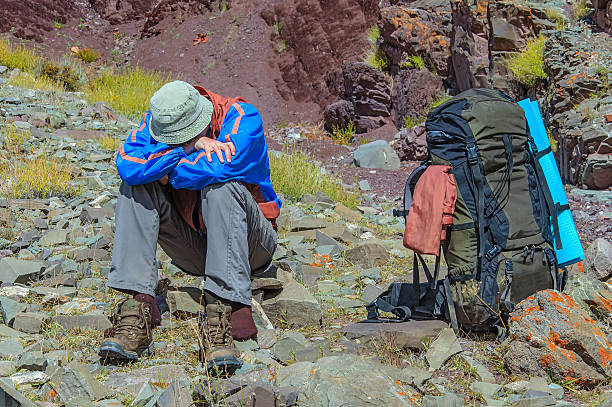
Altitude sickness also known as acute mountain sickness (AMS) gets sick when trekkers trekking into the mountains at high altitude as you will feel less oxygen is available to breathe. Generally altitude starts after 2500m / 9500 Ft above sea level. Trekkers may begin experiencing initial symptoms of altitude sickness at lower elevations along the trek route.Understanding the early symptoms and following prevention methods is crucial for anyone planning a trek in the high-altitude section of the himalayas.The main reason of altitude sickness is ascending to a great height too rapidly.Average human needs at least 1 day to become acclimatized to adapt the change in altitude.Those people who do not spend enough tie acclimatizing to a new altitude before embarking further have the highest risk of developing altitude sickness.As you know your body better than anyone if you experience something odd or get any hint of altitude sickness then it’s better to let your guide know about your body condition as they will suggest the best advice.
General Symptoms of High altitude
Altitude sickness can start from a different range of symptoms, some travelers can catch altitude sickness with basic to high symptoms and some can only receive just a few symptoms ,but get more serious. As our past experience it all depends on our body how it reacts in the higher section of the trek. Anyway , basic symptoms are given below.
- Headache : At first , when you receive the high altitude headache is one of the most common symptoms of the high altitude sickness in the Himalayas. Especially , when your head hurts more in the back side and inside it’s the altitude sickness symptoms ,but front head pain is normal when you go trek lower altitude to high altitude. Front head can also hurt from winds, dehydration and cold.
- Nausea and Vomiting: numbers of trekkers and mountaineering travelers also received the symptoms of Nausea and vomiting after they get altitude sickness.
- Fatigue : When you feel unusually tired or very weak , not feeling like eating is another common symptom of high altitude .
- Dizziness and lightheadedness : Dizziness and continued lightheadedness is another symptom of high altitude. It also makes you uncomfortable while you are walking into the mountain
- No appetite : when you receive the altitude you don’t feel hungry and it’s another experience of having an altitude in the mountains.
- Insomnia : it’s another common symptom you can feel, like you can’t sleep properly and it makes you more tired and less energetic to continue the trip to the last destination of your trek.
- Oxygen level lower: when you have received altitude sickness your oxygen level will go down like unusual.
How to Prevention high altitude:
When you are trekking to the himalayas and are at a high altitude now you don’t need to worry much about it, we also have the best prevention methods to get away from this sickness ,but we have to follow the basic rules and requirements of prevention. Here are some best prevention suggestions list.
- Acclimatization : When you are planning to trekking or climbing in the Himalaya , Nepal or anywhere in the world, acclimatization is the first and best prevention of high altitude sickness. When you plan your itinerary, make a flexible itinerary and add extra days during the trek. As you have a flexible time encase if you feel altitude you can take rest and do the acclimatization. When you reach a higher section any trekking in the himalayas does the proper acclimatization such as after 3000m you can always go a few hundreds higher and come back to sleep lower which also helps you lots.
- Stay Dehydrate : Drink as much as possible. Drink a list a day of 3 to 4 liters of water. And take garlic soups or any other items and if you feel cold then drink boiled water instead of cold water.
- Rest : If you feel altitude , take a rest where you are. Don’t walk or go higher. Just drink and try to eat healthy food.
- Descending : Descending is one of the common precautions for high altitude. If you experience high altitude then at list 300 to 400m descend will save your life in the mountain.
- Listen to your Guide : When you receive symptoms please share with your guide or your trekking partner. If you don’t share it they don’t. So, there can be more problems to prevent. When you start to experience it, please share with your guide who will suggest the best way to save life on the mountain.
- Avoid alcohol and smoke : Do not drink alcohol or smoke while you are on the trek.it can be another reason to start the altitude.
- Medication : You can also get high altitude medicine can Dymaox . Your guide can brief you about this medicine when, and how to use it.
Overall Altitude sickness also known as acute mountain sickness(AMS),occurs when trekkers go to the high altitude(above 2,500m/9500 ft) and experience oxygen levels.Early symptoms includes:Headache,nausea,vomiting,Fatigue,dizziness,Lack of appetite,insomnia and lower oxygen levels .It’s important to recognize and respond to these symptoms by informing your guide.
To prevent from altitude sickness,trekkers needs to acclimatize by gradually adjusting taking some rest while embarking in the higher altitude.Drinking plenty of water,avoiding alcohol and smoking are crucial things to avoid the altitude sickness.Descending if necessary is important as your body may need time to adjust lower altitudes to recover from symptoms and stabilize.Guides are knowledgeable about altitude sickness and have experience,so it’s best to follow their advice.If you embarking in the higher region then make sure you customize your itinerary including Acclimatization day.




